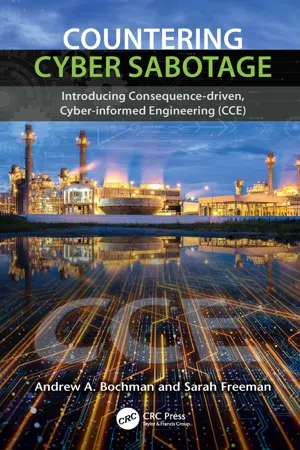
Countering Cyber Sabotage
Introducing Consequence-Driven, Cyber-Informed Engineering (CCE)
- 276 pages
- English
- ePUB (mobile friendly)
- Available on iOS & Android
Countering Cyber Sabotage
Introducing Consequence-Driven, Cyber-Informed Engineering (CCE)
About this book
Countering Cyber Sabotage: Introducing Consequence-Driven, Cyber-Informed Engineering (CCE) introduces a new methodology to help critical infrastructure owners, operators and their security practitioners make demonstrable improvements in securing their most important functions and processes.
Current best practice approaches to cyber defense struggle to stop targeted attackers from creating potentially catastrophic results. From a national security perspective, it is not just the damage to the military, the economy, or essential critical infrastructure companies that is a concern. It is the cumulative, downstream effects from potential regional blackouts, military mission kills, transportation stoppages, water delivery or treatment issues, and so on. CCE is a validation that engineering first principles can be applied to the most important cybersecurity challenges and in so doing, protect organizations in ways current approaches do not. The most pressing threat is cyber-enabled sabotage, and CCE begins with the assumption that well-resourced, adaptive adversaries are already in and have been for some time, undetected and perhaps undetectable.
Chapter 1 recaps the current and near-future states of digital technologies in critical infrastructure and the implications of our near-total dependence on them. Chapters 2 and 3 describe the origins of the methodology and set the stage for the more in-depth examination that follows. Chapter 4 describes how to prepare for an engagement, and chapters 5-8 address each of the four phases. The CCE phase chapters take the reader on a more granular walkthrough of the methodology with examples from the field, phase objectives, and the steps to take in each phase. Concluding chapter 9 covers training options and looks towards a future where these concepts are scaled more broadly.
Frequently asked questions
- Essential is ideal for learners and professionals who enjoy exploring a wide range of subjects. Access the Essential Library with 800,000+ trusted titles and best-sellers across business, personal growth, and the humanities. Includes unlimited reading time and Standard Read Aloud voice.
- Complete: Perfect for advanced learners and researchers needing full, unrestricted access. Unlock 1.4M+ books across hundreds of subjects, including academic and specialized titles. The Complete Plan also includes advanced features like Premium Read Aloud and Research Assistant.
Please note we cannot support devices running on iOS 13 and Android 7 or earlier. Learn more about using the app.
Information
1
Running to Stand Still and Still Falling Behind
“I Can Deal with Disruption; I Can’t Handle Destruction”
Implications for Critical Infrastructure and National Security
Faith that governments—including the U.S.—can respond to attacks in a timely and effective way may also be misplaced. I just say—God forbid—that on a hot summer day, [after a] cyberattack, pressure [in] the water pipelines in California will drop to zero. Thinking that the federal government will assist, solve the problem—it’s not even a dream.7
Goodbye to Full Manual: Automating Critical Infrastructure
I call it “A Day without SCADA.” Many operators indicate that they are not sure if they could run their systems without SCADA. Over the last few decades, as automation improved in reliability and was designed into all their systems, utilities began cutting back on their operator workforce. For example, a 50 million gallons per day (MGD) water treatment facility without SCADA may have had up to 3 full time operators 24 hours per day. After automation was implemented, these facilities may be operated by the SCADA system with oversight from a remote location, with only one operator and maintenance staff on hand during the day shift only. In this “lean” configuration of staffing, if the SCADA system suddenly became unavailable, they could keep things running by relying on on-call staff and required overtime, or even perhaps mutual aid from a nearby utility. However, the load on their staff would become unbearable if the outage dragged on for days and weeks.Other utilities have indicated that they have a regularly scheduled “Day without SCADA” as an operations activity at least annually. Management views these exercises as excellent training opportunities to verify that operators know how to run the plants in a manual fashion. However, these utilities indicate that running these exercises are a significant burden that no one looks forward to and can create operational issues.Another key element in the equation are vendor systems. Many vendor systems (Reverse Osmosis, for example) are very complex and are not designed to be run without the automation. Several water utility operators have indicated that ...
Table of contents
- Cover
- Half Title
- Title Page
- Copyright Page
- Contents
- Foreword
- Preface
- Author Bio
- Introduction
- 1 Running to Stand Still and Still Falling Behind
- 2 Restoring Trust: Cyber-Informed Engineering
- 3 Beyond Hope and Hygiene: Introducing Consequence-Driven Cyber-Informed Engineering
- 4 Pre-engagement Preparation
- 5 Phase 1: Consequence Prioritization
- 6 Phase 2: System-of-Systems Analysis
- 7 Phase 3: Consequence-Based Targeting
- 8 Phase 4: Mitigations and Protections
- 9 CCE Futures: Training, Tools, and What Comes Next
- Acknowledgments
- Glossary
- Appendix A CCE Case Study: Baltavia Substation Power Outage
- Appendix B CCE Phase Checklists
- Index